Page 54 of 329
To deactivate the lockable retractor
and remove a child seat, unlatch the
buckle, unroute the seat belt, and let
the belt fully retract.
Push and pull the child seat
f orward and f rom side-to-side to
verify that it is secure enough to
stay upright during normal driving
maneuvers. If the child seat is not
secure, unlatch the belt, allow it to
retract f ully, then repeat these
steps.
To remove slack, it may help to
putweightonthechildseat,or
push on the back of the seat while
pulling up on the belt.
Af ter conf irming that the belt is
locked, grab the shoulder part of
the belt near the buckle, and pull
up to remove any slack from the
lap part of the belt. Remember, if
the lap part of the belt is not tight,
the child seat will not be secure.
4. 5.
Installing a Child Seat
50
�\f���—�\f���—�\f���y�
�
��
����
���y���
�(���+�����\f�y�\f�\f�����y
2008 Pilot
Page 55 of 329
Each second row seat has a tether
anchorage point behind the seat-
back.
A child seat with a tether can be
installed in any seating position in
the second or third row seats.
Since a tether can provide additional
security to the lap/shoulder belt
installation, we recommend using a
tether whenever one is required or
available.
Af ter properly securing the child
seat (see page ), lif t the head
restraint, then route the tether
strap over the seat-back and
through the head restraint legs.
1.
49
CONT INUED
Installing a Child Seat
Installing a Child Seat with a
TetherSecond Row Inst allat ion
Driver and Passenger Saf ety
51
TETHER ANCHORAGE P OINT
�\f���—�\f���—�\f���y�
�
��
��������y���
�(���+�����\f�y�\f�\f�����y
2008 Pilot
Page 57 of 329
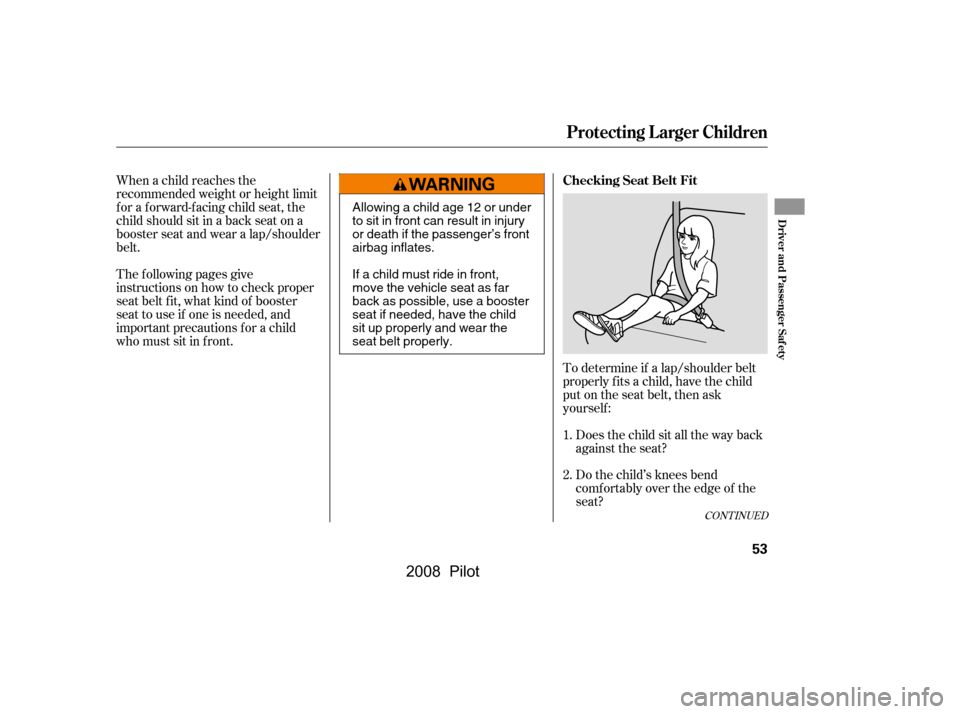
To determine if a lap/shoulder belt
properly f its a child, have the child
put on the seat belt, then ask
yourself :
When a child reaches the
recommended weight or height limit
for a forward-facing child seat, the
child should sit in a back seat on a
booster seat and wear a lap/shoulder
belt.
Does the child sit all the way back
against the seat?
Do the child’s knees bend
comf ortably over the edge of the
seat?
The f ollowing pages give
instructions on how to check proper
seat belt f it, what kind of booster
seat to use if one is needed, and
important precautions f or a child
who must sit in f ront.
1.
2.
CONT INUED
Protecting L arger Children
Checking Seat Belt Fit
Driver and Passenger Saf ety
53
Allowing a child age 12 or under
to sit in front can result in injury
or death if the passenger’s front
airbag inflates.
If a child must ride in front,
move the vehicle seat as far
back as possible, use a booster
seat if needed, have the child
sit up properly and wear the
seat belt properly.
�����—�����—�����y�
�
��
��������y���
�(���+�������y���������y
2008 Pilot
Page 58 of 329
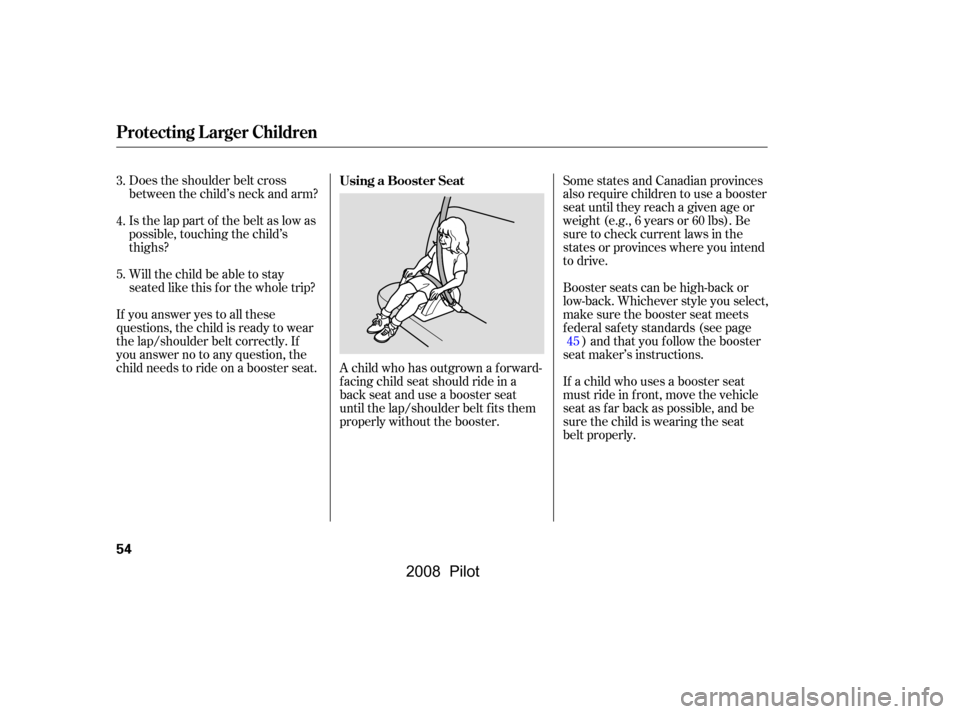
Does the shoulder belt cross
between the child’s neck and arm?
Is the lap part of the belt as low as
possible, touching the child’s
thighs?
Will the child be able to stay
seated like this f or the whole trip?
If you answer yes to all these
questions, the child is ready to wear
the lap/shoulder belt correctly. If
you answer no to any question, the
child needs to ride on a booster seat. A child who has outgrown a f orward- f acing child seat should ride in a
back seat and use a booster seat
until the lap/shoulder belt f its them
properly without the booster.Some states and Canadian provinces
also require children to use a booster
seat until they reach a given age or
weight (e.g., 6 years or 60 lbs). Be
sure to check current laws in the
states or provinces where you intend
to drive.
Booster seats can be high-back or
low-back. Whichever style you select,
make sure the booster seat meets
f ederal saf ety standards (see page
) and that you f ollow the booster
seat maker’s instructions.
If a child who uses a booster seat
must ride in f ront, move the vehicle
seat as far back as possible, and be
sure the child is wearing the seat
belt properly.
4.
5.
3.
45
Using a Booster Seat
Protecting L arger Children
54
�\f���—�\f���—�\f���y�
�
��
��������y���
�(���+�����\f�y�\f�\f�����y
2008 Pilot
Page 59 of 329
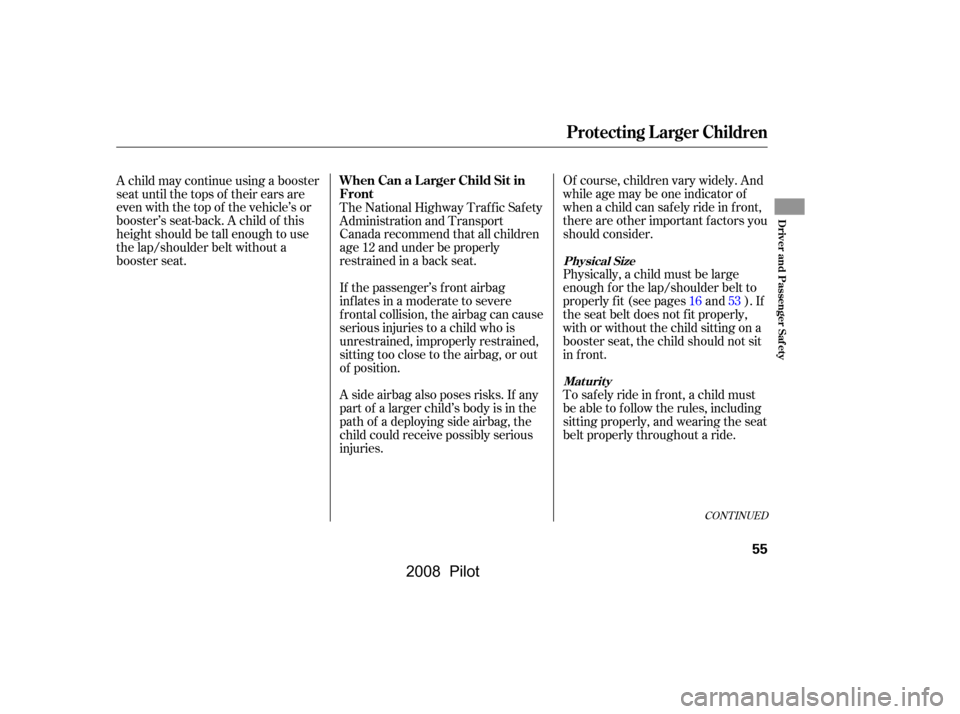
Of course, children vary widely. And
while age may be one indicator of
when a child can saf ely ride in f ront,
there are other important f actors you
should consider.
Physically, a child must be large
enough f or the lap/shoulder belt to
properly f it (see pages and ). If
the seat belt does not f it properly,
with or without the child sitting on a
booster seat, the child should not sit
in f ront.
To saf ely ride in f ront, a child must
be able to f ollow the rules, including
sitting properly, and wearing the seat
belt properly throughout a ride.
A side airbag also poses risks. If any
part of a larger child’s body is in the
path of a deploying side airbag, the
child could receive possibly serious
injuries.
If the passenger’s front airbag
inf lates in a moderate to severe
f rontal collision, the airbag can cause
serious injuries to a child who is
unrestrained, improperly restrained,
sitting too close to the airbag, or out
of position.
The National Highway Traffic Safety
Administration and Transport
Canada recommend that all children
age 12 and under be properly
restrained in a back seat.
A child may continue using a booster
seat until the tops of their ears are
even with the top of the vehicle’s or
booster’s seat-back. A child of this
height should be tall enough to use
the lap/shoulder belt without a
booster seat.
53
16
CONT INUED
Protecting L arger Children
Physical Size
Maturity
When Can a L arger Child Sit in
Front
Driver and Passenger Saf ety
55
�\f���—�\f���—�\f���y�
�
��
��������y���
�(���+�����\f�y�\f�\f���\f�y
2008 Pilot
Page 60 of 329
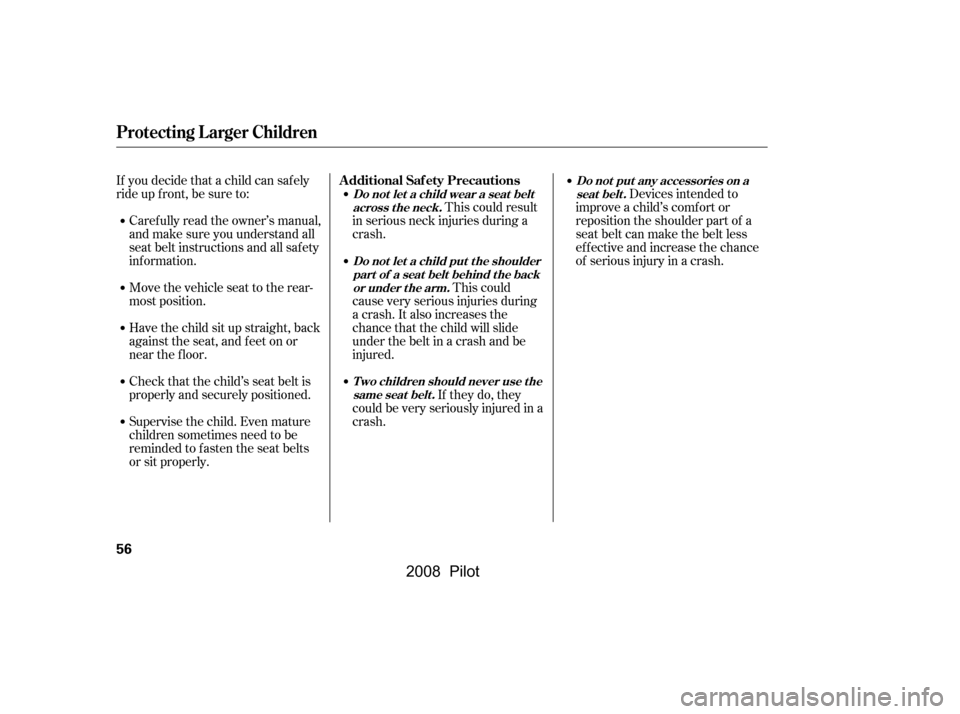
Devices intended to
improve a child’s comf ort or
reposition the shoulder part of a
seat belt can make the belt less
ef f ective and increase the chance
of serious injury in a crash.
This could result
in serious neck injuries during a
crash.
This could
cause very serious injuries during
a crash. It also increases the
chance that the child will slide
under the belt in a crash and be
injured.
If they do, they
could be very seriously injured in a
crash.
If you decide that a child can saf ely
ride up f ront, be sure to:
Caref ully read the owner’s manual,
and make sure you understand all
seat belt instructions and all saf ety
inf ormation.
Move the vehicle seat to the rear-
most position.
Have the child sit up straight, back
against the seat, and feet on or
near the f loor.
Check that the child’s seat belt is
properly and securely positioned.
Supervise the child. Even mature
children sometimes need to be
reminded to f asten the seat belts
or sit properly.
Protecting L arger Children
Do not put any accessories on aseat belt.
Do not let a child wear a seat belt
across t he neck.
Do not let a child put the shoulderpart of a seat belt behind t he backor under t he arm.
T wo children should never use thesame seat belt .Additional Saf ety Precautions
56
�\f���—�\f���—�\f���y�
�
����\f��\f�
�y���
�(���+�����\f�y�\f�\f���
�y
2008 Pilot
Page 65 of 329
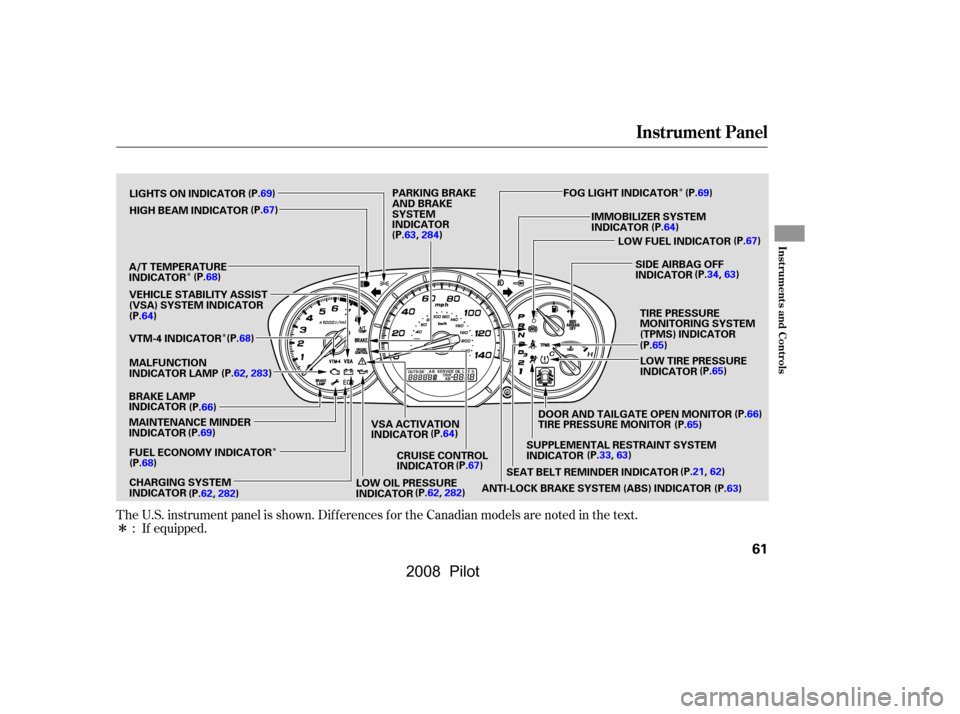
�Î
�Î�Î
�Î �Î
If equipped.
The U.S. instrument panel is shown. Dif f erences f or the Canadian models are noted in the text.
:
Instrument Panel
Inst rument s and Cont rols
61
LIGHTS ON INDICATOR
HIGH BEAM INDICATOR
A/T TEMPERATURE
INDICATOR
MAINTENANCE MINDER
INDICATOR LOW OIL PRESSURE
INDICATORVSA ACTIVATION
INDICATOR
CRUISE CONTROL
INDICATOR SIDE AIRBAG OFF
INDICATOR
LOW FUEL INDICATOR
FOG LIGHT INDICATOR
(P.69)
(P.69) (P.69)
SEAT BELT REMINDER INDICATOR
(P.67)
(P.68)
(P.64)
VTM-4 INDICATOR (P.68)
FUEL ECONOMY INDICATOR (P.68)
CHARGING SYSTEM
INDICATOR (P.64)
(P.67) (P.65)
(P.66)
(P.65)
IMMOBILIZER SYSTEM
INDICATOR
(P.64)
(P.67)
PARKING BRAKE
AND BRAKE
SYSTEM
INDICATOR
SUPPLEMENTAL RESTRAINT SYSTEM
INDICATOR
MALFUNCTION
INDICATOR LAMP
BRAKE LAMP
INDICATOR (P.66) LOW TIRE PRESSURE
INDICATOR
(P.65) TIRE PRESSURE
MONITORING SYSTEM
(TPMS) INDICATOR
VEHICLE STABILITY ASSIST
(VSA) SYSTEM INDICATOR
ANTI-LOCK BRAKE SYSTEM (ABS) INDICATOR(P.34,63)
(P.33,63)
DOOR AND TAILGATE OPEN MONITOR
TIRE PRESSURE MONITOR
(P.63)
(P.21,62)
(P.62,283)
(P.62,282) (P.62,282)
(P.63,284)
�\f���—�\f���—�\f���y�
�
����\f������y���
�(���+�����\f�y�\f�\f�����y
2008 Pilot
Page 66 of 329
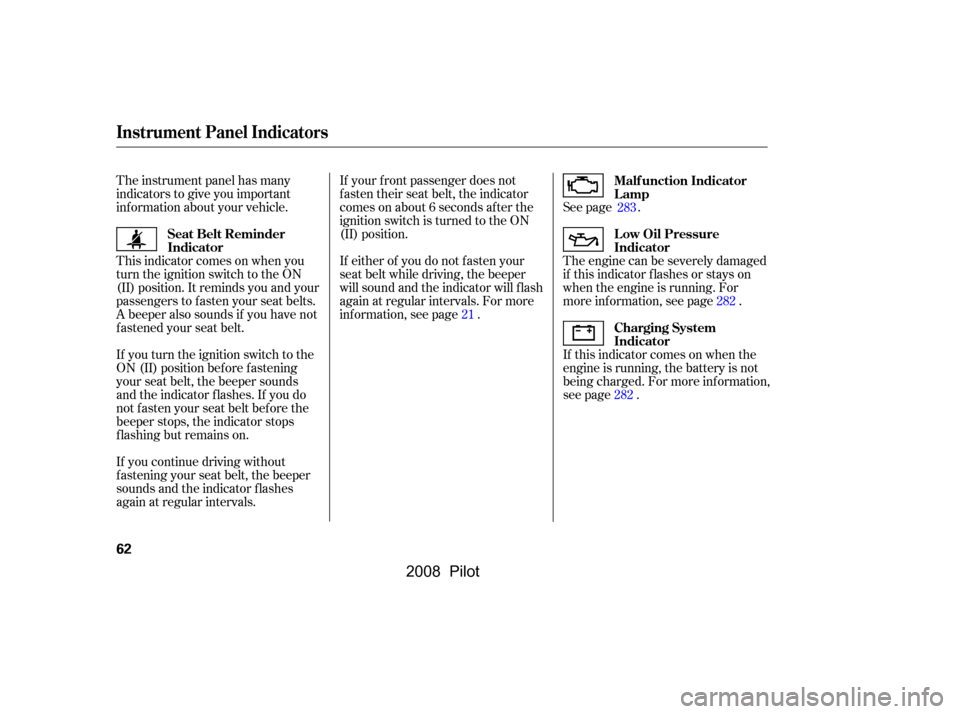
The instrument panel has many
indicators to give you important
inf ormation about your vehicle. See page .The engine can be severely damaged
if this indicator f lashes or stays on
when the engine is running. For
more information, see page .
If this indicator comes on when the
engine is running, the battery is not
being charged. For more inf ormation,
see page .
If either of you do not f asten your
seat belt while driving, the beeper
will sound and the indicator will f lash
again at regular intervals. For more
inf ormation, see page .
If your f ront passenger does not
f asten their seat belt, the indicator
comes on about 6 seconds af ter the
ignition switch is turned to the ON
(II) position.
This indicator comes on when you
turn the ignition switch to the ON
(II) position. It reminds you and your
passengers to f asten your seat belts.
A beeper also sounds if you have not
f astened your seat belt.
If you turn the ignition switch to the
ON (II) position bef ore f astening
your seat belt, the beeper sounds
and the indicator f lashes. If you do
notfastenyourseatbeltbeforethe
beeper stops, the indicator stops
f lashing but remains on.
If you continue driving without
f astening your seat belt, the beeper
sounds and the indicator f lashes
again at regular intervals. 21
283
282
282
Malf unction Indicator
Lamp
L ow Oil Pressure
Indicator
Charging System
Indicator
Seat Belt Reminder
Indicator
Instrument Panel Indicators
62
�\f���—�\f���—�\f���y�
�
����
��\f�
�y���
�(���+�����\f�y�\f�\f�����y
2008 Pilot